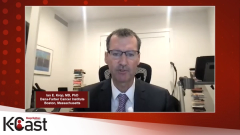
Dual HER2-Targeted Therapy for MBC
The rationale for treating metastatic breast cancer with a dual HER2-targeted therapy approach.
Episodes in this series

Briana Contreras: What is the rationale for the use of dual HER2-targeted monoclonal antibody therapy?
Ian E. Krop, MD, PhD: There are now several different ways to do dual HER2 therapies. The one we first figured out was the combination of trastuzumab with pertuzumab, as you asked about, 2 different antibodies. That’s based on the fact that even though they both target HER2, they target different spots on the molecule, different epitopes on the HER2 molecule. That allows them to block the different types of signaling of HER2, and different methods of dimerization. That’s relevant because it looks like one of the ways cancers were getting around the effects of trastuzumab was activating a pathway, whereas HER2 would bind to other similar molecules that trastuzumab doesn’t block, but pertuzumab does. By combining trastuzumab and pertuzumab, you can block both of those signaling pathways and overcome resistance. That was shown in clinical trials to be advantageous with a big survival benefit compared to either one alone. There are also data combining antibodies like trastuzumab with tyrosine kinase inhibitors, like lapatinib or tucatinib. That’s a part of the rationale for the HER2CLIMB regimen, using both trastuzumab and tucatinib along with capecitabine. Because of synergistic effects on HER2 signaling, you get better efficacy than using one of those alone.
Briana Contreras: What are the data that led to the incorporation of dual HER2-targeted therapy as part of the treatment landscape for metastatic disease?
Ian E. Krop, MD, PhD: That’s the data we were talking about. In the first line, we had this CLEOPATRA trial that compared chemotherapy and trastuzumab versus chemotherapy and dual therapy of trastuzumab and pertuzumab. There was a 16-month survival benefit by adding pertuzumab, showing unequivocally more efficacy when you use those dual approaches. There have been smaller studies looking at combining antibodies with tyrosine kinase inhibitors, including this HER2CLIMB trial, which used trastuzumab and chemotherapy with or without the tyrosine kinase inhibitor tucatinib. It showed a benefit in terms of survival by adding 2 HER2 therapies versus 1 alone.
Briana Contreras: Can you please describe some of the issues surrounding administration of dual HER2 therapy in the metastatic setting?
Ian E. Krop, MD, PhD: There are some practical things. When you’re combining an oral therapy with an antibody, it’s more complicated for patients. They have to come in to get their infusions, and have to take oral medications at home. They need a lot of coaching for that to make sure they are taking their oral regimen correctly, and having to come in as well. There is a problem with using 2 different antibodies, each with its own infusion time, leading to longer times that patients have to stay in the infusion room. That’s being addressed in part by products combining trastuzumab and pertuzumab into 1 drug, which cuts down the infusion time. There are also subcutaneous versions of the combination, which completely get rid of the infusion time. The market is working to get around some of the hassles of using multiple HER2-targeted therapies. But until that problem is completely solved, it is more complicated, both for patients and providers, to use multiple HER2 therapies as opposed to 1; there is a cost.
Briana Contreras: As you mentioned cost, how do cost considerations factor into your treatment decision-making?
Ian E. Krop, MD, PhD: Fortunately, I’m an academic oncologist, and I work in a state that has a relatively high number of patients who have good health insurance. But at least in the HER2 therapy world, cost hasn’t been much of a direct challenge for patients. It’s been a long time since I’ve had a patient have a problem with out-of-pocket payment for these drugs. Even the oral agent tucatinib, I haven’t had that issue so far. That’s what patients are experiencing; it hasn’t been a problem. These drugs are incredibly expensive, and it’s a big challenge for the health care industry and our society. We are combining more than 1 of them; obviously, that’s more expensive than using 1 drug alone. It is a societal problem that we’re going to have to deal with. But at least at the individual patient level right now, cost, in my experience, has not been a real problem in this particular arena.
Transcript edited for clarity.
Newsletter
Get the latest industry news, event updates, and more from Managed healthcare Executive.



























































